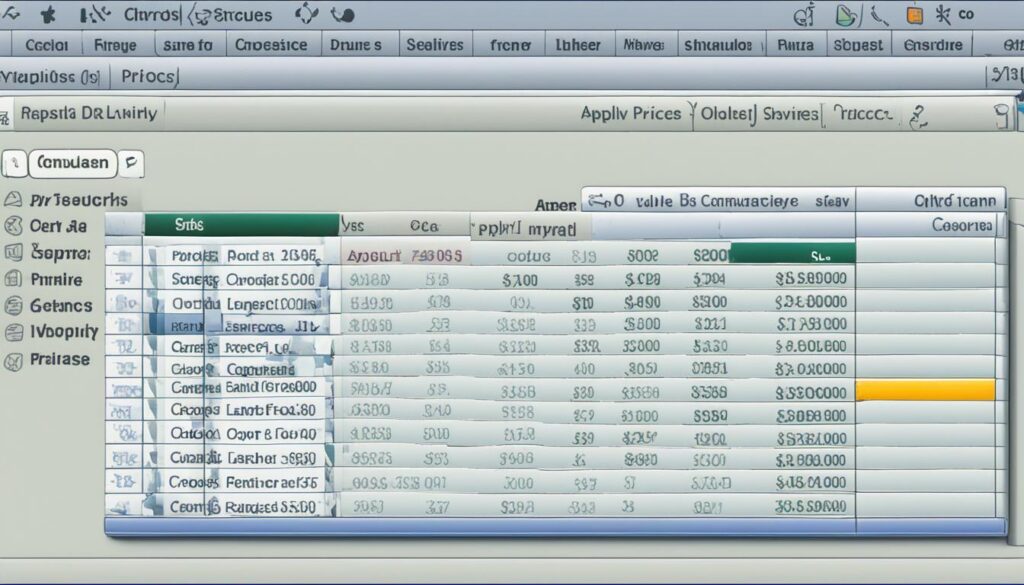If you manage an online store, you know that staying on top of pricing updates can be a time-consuming and complicated process. But with bulk pricing updates, you can simplify this task and save valuable time. By making changes to multiple products at once, these updates ensure pricing accuracy and maintain your competitive edge.
In this article, we’ll dive into why bulk pricing updates are essential for online stores, the benefits of using a bulk price updating tool, how to perform automated bulk price updates, and best practices for efficient bulk price adjustments. We’ll also cover strategies to ensure pricing accuracy in bulk updates and overcoming challenges you may encounter along the way.
So, if you’re ready to streamline your online store management and improve pricing accuracy, keep reading.
Key Takeaways:
- Bulk pricing updates can save time and ensure pricing accuracy for online stores.
- Using a specialized tool can automate and streamline the process.
- Efficient bulk price updating requires organizing product data and leveraging automation features.
- Accuracy can be maintained by performing thorough quality checks and validating data.
- Measuring success through KPIs and metrics is critical for evaluating the impact of bulk pricing updates.
Why Bulk Pricing Updates are Essential for Online Stores
Online stores rely on competitive pricing to attract and retain customers. With a vast catalog of products, managing pricing for all items can be a daunting task. Bulk pricing updates offer a solution by streamlining the process of adjusting prices according to market trends while maintaining accuracy.
Updating prices in bulk ensures that businesses stay ahead of the competition and adjust to customer demand quickly. This approach saves time while ensuring consistency across all products. More importantly, bulk price changes make it easy to track product performance and adjust pricing accordingly, maximizing profitability.
When done manually, performing bulk price modification on a large product catalog can be labor-intensive and error-prone. Utilizing a reliable bulk price updating tool enables businesses to make cost updates in bulk automatically while maintaining pricing accuracy. Moreover, automated bulk price updates enable online stores to scale and seamlessly manage their pricing without the need for additional resources.
An efficient bulk price adjustment strategy is critical for managing pricing across large catalogs of products. By leveraging effective bulk price updating techniques, online stores can streamline processes, maintain accuracy, and improve profitability.
Benefits of Using a Bulk Price Updating Tool
If you want to save time and streamline your online store management, a bulk price updating tool is essential. By using this type of tool, you can modify prices more efficiently and accurately than manual methods. Here are some of the primary benefits of using a bulk price updating tool:
- Automation: A specialized tool allows businesses to automate bulk pricing modifications, which significantly reduces the time and effort required to perform updates.
- Accuracy: Bulk price updating tools eliminate the risk of manual errors in pricing modification, ensuring accuracy while saving time.
- Scalability: With a dedicated tool, businesses can modify the pricing of a large catalog of products quickly and efficiently.
- Flexibility: Some bulk price updating tools offer a range of customization options, including applying discounts across all products, increasing prices, renaming prices, and more.
Case Study: MSC Company Improves Pricing Efficiency with a Bulk Pricing Tool
MSC Company, an Amazon seller who sells grocery and beauty, had been manually updating prices across their entire product catalog. This approach was time-consuming and often led to errors in pricing, which impacted customer satisfaction and sales.
To rectify this issue, MSC Company introduced a bulk price updating tool (Fusion Recpricer)that automated pricing modifications and provided a range of customization options. As a result, they were able to perform modifications with a high level of accuracy and consistency, resulting in increased sales and fewer customer complaints. The company’s pricing department was also able to save significant time and reduce workload leading to more focus on core business activities.
“We were extremely pleased with the results of using a bulk pricing tool. It enabled us to be much more efficient with our pricing updates, and we were able to achieve much greater accuracy than using manual methods. We would highly recommend it to other businesses looking to streamline their online store management.” – Tim, MSC Company
How to Perform Automated Bulk Price Updates
Automated bulk price updates can save time and effort while ensuring pricing accuracy across a large catalog of products. Here are some essential steps to execute an automated bulk price update:
- Select an appropriate tool: Consider using a specialized bulk price updating tool that caters to your business needs and is compatible with your eCommerce platform. Some popular options include Trade Gecko, QuickBooks, and Prisync.
- Import pricing data: Use the tool to import the pricing data for your products from your eCommerce platform’s database or an Excel file. Ensure the data is correctly formatted and accurately reflects the current prices for your products.
- Set up price adjustment rules: Use the tool to set up price adjustment rules that specify how the prices will change. You can adjust prices by a percentage or a fixed amount to stay competitive with market trends and attract customers.
- Execute the bulk price update: Once you’ve verified the pricing data and set up the rules, you can execute the bulk update. The tool should automatically update the prices for all products in your catalog.
- Validate pricing data: After the bulk update, validate the pricing data to ensure accuracy and consistency. Check for any errors or inconsistencies in the update and make corrections, if necessary.
Utilizing a bulk price updating tool to automate the process can save time and resources while ensuring pricing accuracy. It’s important to select an appropriate tool, import pricing data correctly, set up price adjustment rules, execute the update, and validate the pricing data to ensure accuracy.
Ensuring Pricing Accuracy in Bulk Updates
When making bulk price modifications or cost updates in bulk, it’s crucial to ensure the accuracy of pricing to avoid pricing inconsistencies or errors that can negatively impact sales and customer satisfaction. To this end, businesses can implement a range of strategies including:
- Performing thorough quality checks: Before applying any changes, it’s essential to ensure that the data is ‘clean’. This means ensuring that there are no data duplicates, inconsistencies, or formatting issues in the spreadsheet or data source.
- Validating the data: Another way to improve pricing accuracy when making bulk updates is to use data validation rules to check that the data is within the expected values. By setting validation rules, businesses can reduce the risk of errors due to incorrect data entry or formatting.
- Implementing safeguards: In addition, it’s essential to put in place safeguards to prevent unintended pricing modifications, such as setting up approval workflows, enabling audit logs, or limiting access to pricing data.
By taking these measures, businesses can ensure that their bulk price modifications and cost updates in bulk are accurate, reducing pricing errors and minimizing the risk of negative impact on sales.

“Accuracy of pricing is paramount when making bulk updates; validating the data, performing quality checks and implementing safeguards are some of the techniques to ensure it.”
Overcoming Challenges in Bulk Pricing Updates
While conducting bulk price modifications can offer significant benefits, certain challenges may arise. It’s important to anticipate and address these potential issues to ensure a smooth and successful process.
Challenges to Consider
Frequent challenges include pricing discrepancies in the catalog, difficulty in implementing price adjustments across multiple platforms, and the possibility of human error during manual updates.
Another common issue is the potential for system glitches or data corruption during the upload or processing of pricing updates.
Effective Solutions
Fortunately, there are several proven solutions for overcoming these bulk pricing challenges. One effective strategy is to utilize a bulk price updating tool that automates the process of updating pricing information across multiple channels, mitigating human error risks.
In addition, setting up clear guidelines and conducting regular quality checks can help prevent pricing discrepancies and ensure that modifications are accurately executed.
“Automated tools offer control and efficiency while reducing the potential for errors.”
When navigating system glitches or processing errors, having a contingency plan in place can minimize the impact of such issues. Businesses can develop backup strategies such as maintaining backups of critical data and setting up redundant systems for pricing data processing.
Best Practices for Efficient Bulk Price Updates
When it comes to updating prices in bulk, it’s crucial to have a streamlined process in place to optimize efficiency. Here are some best practices to follow when performing bulk price adjustments:
- Set realistic timelines: Avoid rushing the process and set realistic deadlines to ensure accuracy and attention to detail.
- Organize product data: Keep your pricing data organized and structured in a way that is easy to manage. Consider using a spreadsheet or specialized tool to help with organization.
- Leverage automation features: Utilize automation features to save time and effort, such as automatically updating prices based on rules or formulas.
By following these best practices, businesses can ensure that their bulk price updates are not only efficient but also accurate, saving time and labor costs in the long run.
“Effective pricing requires discipline and careful consideration. It’s important to be mindful of the impact of bulk price adjustments on your business and the market.”
Measuring the Success of Bulk Pricing Updates
Monitoring and evaluating the impact of bulk pricing modification is critical to ensuring that your online store’s pricing strategy is optimized for success. By keeping a close eye on key performance indicators (KPIs) and metrics, you can gain valuable insights into the effectiveness of your pricing updates and make data-driven decisions to improve your strategy moving forward.
Some KPIs to consider when measuring the success of bulk pricing updates include:
- Sales revenue: This is perhaps the most obvious metric to track. By comparing revenue before and after bulk pricing updates, you can gauge the impact on your bottom line.
- Customer feedback: Keeping an ear to the ground and monitoring customer feedback–both positive and negative–can give you valuable insights into the effectiveness of your pricing strategy.
- Competitive pricing analysis: Keeping tabs on your competitors’ prices can help you identify areas where you can adjust your pricing to stay competitive.
By taking a data-driven approach to measuring the success of bulk pricing updates, you can ensure that your pricing strategy remains effective and your online store remains competitive.
Don’t let your pricing strategy fall behind the times! Stay up-to-date with bulk pricing modification and optimize your online store for success.
Bulk Pricing Updates Wrap Up
Implementing efficient bulk price updating strategies can save time while ensuring pricing accuracy across a large catalog of products. By utilizing a specialized bulk price updating tool, businesses can achieve automation and accuracy, facilitating quick and hassle-free modifications to pricing.
It is essential to overcome common challenges such as complexity and consistency when conducting bulk pricing updates. Organizing product data, setting realistic timelines, and leveraging automation features can optimize the efficiency of bulk price updates.
By measuring the success of bulk pricing updates through KPIs and metrics, businesses can monitor and evaluate their impact on sales revenue, customer satisfaction, and competitive pricing analysis. Overall, implementing best practices for efficient bulk pricing updates can streamline online store management and improve pricing accuracy, ultimately leading to success in the eCommerce market.
Learn More About Amazon Seller Pricing
FAQ
Why should I consider using bulk pricing updates for my online store?
Bulk pricing updates are essential for online stores because they save time and ensure pricing accuracy across your catalog. Instead of manually updating prices one by one, you can make changes in bulk, streamlining your eCommerce operations.
What are the benefits of using a bulk price updating tool?
A bulk price updating tool offers several advantages. It allows for efficient and accurate modifications to pricing across multiple products. By automating the process, it eliminates the need for manual updates and reduces the risk of errors or inconsistencies.
How can I perform automated bulk price updates?
To conduct automated bulk price updates, you can follow these steps:
1. Select a suitable bulk price updating tool.
2. Import your pricing data into the tool.
3. Set up price adjustment rules or formulas.
4. Execute the bulk price update.
5. Verify and validate the updated prices.
How can I ensure pricing accuracy when making bulk updates?
To maintain pricing accuracy during bulk updates, you can use the following strategies:
1. Perform thorough quality checks before and after the update.
2. Validate data integrity and consistency.
3. Implement safeguards to prevent errors, such as keeping backups of the original pricing data.
4. Test the updated prices in a controlled environment before deploying them to the live store.
What challenges may I encounter when conducting bulk pricing updates?
Some common challenges in bulk pricing updates include data formatting issues, software compatibility problems, and the risk of unintended price changes. To overcome these challenges, ensure your data is properly formatted, choose a reliable tool, and double-check the update settings before executing the changes.
What are some best practices for efficient bulk price updates?
To optimize the efficiency of bulk price updates, consider the following best practices:
1. Set realistic timelines and allocate dedicated resources.
2. Organize your product data in a structured and consistent manner for easier manipulation.
3. Leverage automation features provided by the bulk price updating tool.
4. Prioritize and schedule updates based on product categories or sales performance.
How can I measure the success of my bulk pricing updates?
To measure the success of your bulk pricing updates, monitor key performance indicators (KPIs) such as overall sales revenue, customer feedback, and competitive pricing analysis. Regularly assess the impact of the new prices on your business metrics to ensure the updates are driving positive results.




